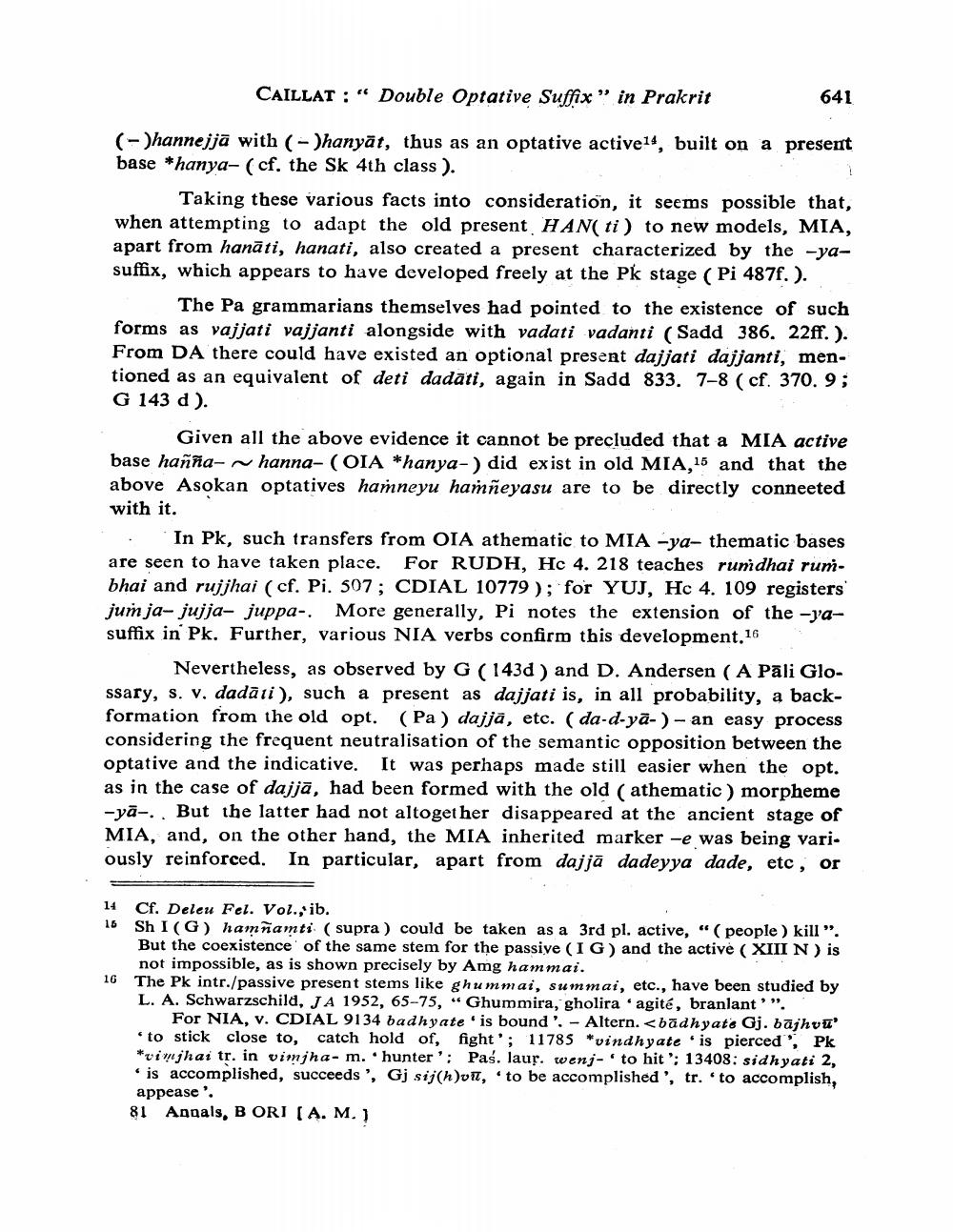Book Title: Double Optative Suffix In Prakrit Asoka XIII Na Hamnesu Na Hamneyasu Author(s): Colette Caillat Publisher: Colette Caillat View full book textPage 5
________________ CAILLAT : " Double Optative Suffix” in Prakrit 641 (-)hannejjā with (-)hanyāt, thus as an optative active14, built on a present base *hanya-(cf. the Sk 4th class ). Taking these various facts into consideration, it seems possible that, when attempting to adapt the old present HAN(ti) to new models, MIA, apart from hanāti, hanati, also created a present characterized by the -yasuffix, which appears to have developed freely at the Pk stage ( Pi 487f.). The Pa grammarians themselves had pointed to the existence of such forms as vajjati vajjanti alongside with vadati vadanti (Sadd 386, 22ff.). From DA there could have existed an optional present dajjati dajjanti, mentioned as an equivalent of deti dadati, again in Sadd 833. 7-8 (cf. 370. 9; G 143 d). Given all the above evidence it cannot be precluded that a MIA active base hañña- hanna- (OIA *hanya-) did exist in old MIA, 15 and that the above Asokan optatives hamneyu hamñeyasu are to be directly conneeted with it. . In Pk, such transfers from OIA athematic to MIA -ya-thematic bases are seen to have taken place. For RUDH, Hc 4. 218 teaches rumdhai runbhai and rujjhai (cf. Pi. 507; CDIAL 10779); for YUJ, Hc 4. 109 registers jum ja- jujja- juppa-. More generally, Pi notes the extension of the -yasuffix in Pk. Further, various NIA verbs confirm this development. 16 Nevertheless, as observed by G (143d) and D. Andersen (A Pāli Glossary, s. v. dadāti), such a present as dajjati is, in all probability, a backformation from the old opt. (Pa) dajjā, etc. (da-d-ya-) - an easy process considering the frequent neutralisation of the semantic opposition between the optative and the indicative. It was perhaps made still easier when the opt. as in the case of dajjā, had been formed with the old (athematic) morpheme -ya-.. But the latter had not altogether disappeared at the ancient stage of MIA, and, on the other hand, the MIA inherited marker -e was being vari. ously reinforced. In particular, apart from dajjā dadeyya dade, etc, or 14 16 16 Cf. Deleu Fel. Vol., ib. Sh I (G) hamñamti (supra) could be taken as a 3rd pl. active, “ (people ) kill ". But the coexistence of the same stem for the passive (IG) and the active (XIII N) is not impossible, as is shown precisely by Amg ham mai. The Pk intr./passive present stems like ghummai, summai, etc., have been studied by L. A. Schwarzschild, JA 1952, 65-75, “Ghummira, gholira 'agité, branlant'". For NIA, V. CDIAL 9134 badhyate is bound'. - Altern. <bädhyate Gj. bajhuu' to stick close to catch hold of, fight'; 11785 *vindhyate is pierced', Pk *viwjhai tr. in vimjha-m..hunter': Pas. laur. wenj- 'to hit '; 13408: sidhyati 2, • is accomplished, succeeds!, Gj sij(h)ot, to be accomplished', tr. 'to accomplish, appease. 81 Angals, BORI (A. M.)Page Navigation
1 ... 3 4 5 6 7 8 9
